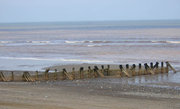Groyne
|
|
Template:Commons A groyne (groin in the United States) is a method of coastal defense against erosion. Groynes are structures running perpendicular to the shoreline, across a beach into the sea. Groynes are usually made of wood, concrete or, most commonly, piles of large rocks. The effect of a groyne is to accumulate sand on the updrift side where littoral drift is predominately in one direction. They are effective at causing the deposition of beach material on the one side, but there is a corresponding loss of beach material on the downdrift side, requiring that another groyne be built there.
Groynes are extremely cost-effective coastal defense measures, requiring little maintenance, and despite costing approximately $310,000 (€280,000 or £195,000) (ref?) in 2003 are one of the most common coastal defense structures. However, groynes are increasingly viewed as detrimental in the long term, and are no longer accepted in many coastal communities.

